Developmental: Toys and Equipment for Your Baby
These instructions for caregivers of Children's Hospital of Philadelphia (CHOP) patients provide recommendations about which toys and equipment should be used and avoided as babies learn to roll, crawl, sit and stand.
Important information:
-
Babies learn to roll, crawl and walk by actively moving. Playing freely on the floor is the best activity. "Containers" are baby equipment such as jumpers, saucers, swings, car seats and strollers. Containers limit a baby's movements.
-
Tummy time is recommended for a total of 60 minutes each day. Tummy time helps babies learn new skills, become strong and helps a baby's head stay round. Tummy time takes the pressure off the back of a baby's head. During tummy time, a baby should be awake, calm and watched by a caregiver.
-
Limit the use of car seats, carriers and swings. Car seats are required for transportation. Take your baby out of the car seat or carrier when not transporting your baby.
-
Research tells us babies in containers have decreased movement in their legs. Babies who kick and move their legs crawl, stand and walk earlier than babies who spend more time in containers.
Recommended for your baby
Playmats, playpens, play yards
Tummy time and playing freely on the floor helps babies to roll, prop on their arms, move on their belly and crawl.
|
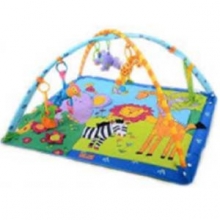 |
Positioning pillows
-
Ask your physical or occupational therapist about using a positioning pillow to help position your baby.
-
Positioning pillows help babies to sit and play on their tummies and backs.
-
Only use positioning pillows when supervising your baby.
|
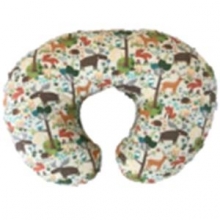 |
Play tables
-
Encourages movement and reaching during tummy time.
-
Helps movement and reaching while sitting.
-
Helps baby stand, take steps, and play.
|
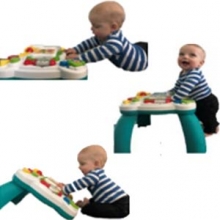 |
Push toys
|
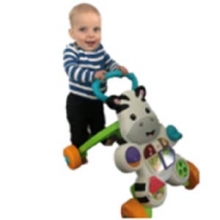 |
Use these containers with caution
Containers do not allow your baby to use muscles, move, see their feet, balance or stand on their own.
-
Before using these containers, your baby should be able to hold their head up and sit by themselves
-
Limit the time your baby spends in these containers to 15-20 minutes.
-
When using a standing play center the baby's seat should be low enough so that their feet are flat on the ground.
|
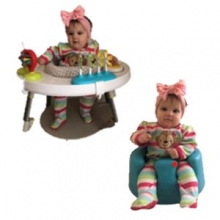 |
Do not use:
Jumpers and baby walkers
-
Babies are not supporting their own weight. They do not have the muscle control for jumping and landing. Landing can put stress on a baby's bones and cause fractures.
-
The American Academy of Pediatrics recommends a ban on all infant walkers due to the risk of injury and delays in development.
|
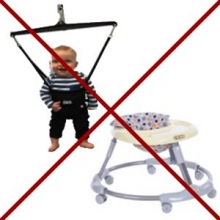 |
Contact your physical therapist and occupational therapist for activities, toys and equipment to help your baby learn new skills.
Reviewed on December 1, 2022, by Colleen Macner Allen, PT, DPT